The Global Airline of Noah and His Heirs
Bifröst, Yggdrasil and the Oracles
An airline that 4’000 years ago linked Hyperborea (Schleswig-Holstein) with Hellas (Greece) and with Magan (Egypt) – is that a figment of imagination by some Sci-Fi freaks? By gullible dreamers who take very thing sensational at face value, just because it is exiting and sensational? But what when the old Skald texts from the Nordic Edda, meticulously compared with archaeological findings, in the light of our present technical knowledge prove exactly that – namely that this airline routes actually existed were used by the Aesirs on a daily basis and in northern latitudes served as launching support for the ascent to gigantic satellites? So let us follow in the footsteps of the Danish researcher Preben Hansson in wide-eyed wonder …
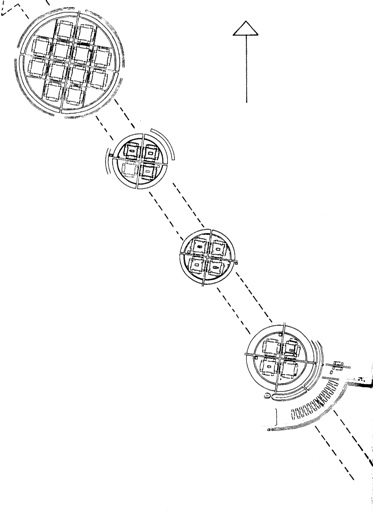
Bifröst, die Asenbrücke: Die dänische Sektion der Fluganlage, die den gesamten Globus umspannte. Re, der Vater des Noah, ließ diese Anlage um 3 100 v.Chr. für die Titanen- und Asengeschlechter errichten. Die Anlage wurde während des Ragnarök um 1 220 v.Chr. weltweit zerstört. Darstellung nach Preben Hansson, Und sie waren doch da
Bifröst and the Ash Tree Yggdrasil
Preben Hansson flew in his small private aircraft across the west coast of Seeland – the one of the two large Danish islands on which the capital Copenhagen is situated.
Suddenly Hansson’s gaze fell “on the outline of a gigantic radar set-up on the ground”. Then he noticed that there were no structures on the layout.
Finally he realised that below him lay the ancient “ring fortress” of Trelleborg, the former outline of which had been filled with white concrete by archaeologists.
For Preben Hansson this was a key experience. The fact that he amassed in the following years proved to be so coherent and convincing that Danish archaeology received inputs from an unexpected direction. His findings Hansson compiled in the book Und sie waren doch da (And they were here after all).
The Danish archaeologist Poul Nörlund decades ago had headed the excavations at Trelleborg and later became director of the Danish National Museum.
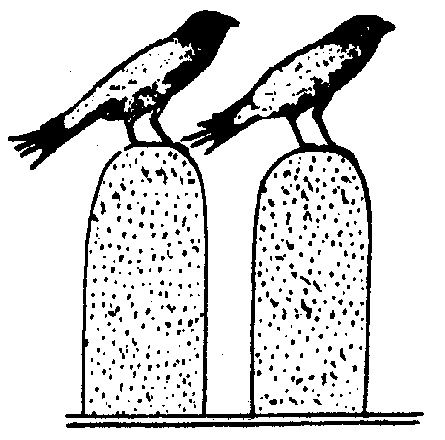
ei Omphaloi mit den obligatorischen Flugsymbolen
Nörlund found that the arrangement could not have been constructed by Vikings, for it was “too clear and regular to have been devised by our Nordic ancestors” – the Vikings – “to whom such orderliness, from all we know about them, was totally alien”.
And Nörlund noticed a second important fact: “It is a complex planned in all detail and erected in one go, not only with sensational exactitude but also with a routine that indicates this was not the first construction of this kind built by those people.”
The Trelleborg site, the layout of which had reminded Hansson so vividly of a modern radar station, possesses a semicircular alignment of the foundations to North West, at 325°. An imaginary parabolic aerial would thus point to a direction that is 35° West of North.
Hansson again took to the skies in his plane and followed the course that the site at Trelleborg indicated. A good hour and 200 kilometres later Hansson had struck twice.
Exactly along the course he found a second complex on the east coast of Jutland near Hobro and a third north of the Limfjord near Aggersborg.
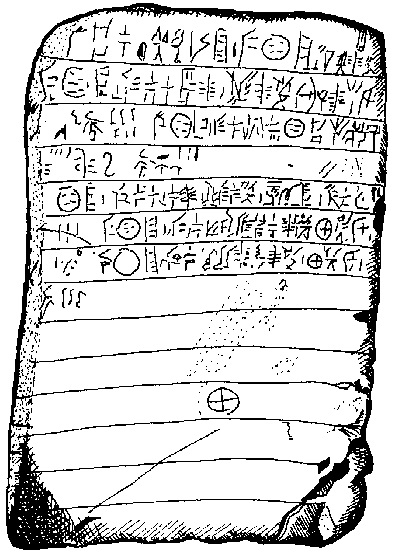
Eine Linear B-Tafel mit dem Trelleborg-Quadranten
Thus Hansson discovered “a direct link by air … across sea and land”. His first summary: “It simply cannot be by accident that these large ring forts had been constructed along one straight line.”
Let us now look at what Hansson found in the following years. The Trelleborg complex in western Seeland once had a breakwater wall of a length of one thousand metres as well as an access road of six kilometres with a bridge across the small river Vaarby.
The complex near Hobro on the eastern border of Jutland still today carries the name Fyrkat (“fire cat”) and lies in the valley of the river Onsild. Hansson found out that the name Onsild was a contraction of the old term Odins Ild. Odins Ild means: “Odin’s fire”.
The third complex near Aggersborg in the North of Jutland Hansson identified as belonging to the former town Lumneta that was also known as Lumne or Jumne. On the oldest Danish map that King Frederik II. had drawn up in 1585 Lumneta is shown as Luxsted.
Both names mean: “town of light”.
Around 1100 AD the priest Adam von Bremen related to his bishop what the Danish King Sven Estridson had told him about the town of light on the Limfjord:
“At the mouth of a river irrigating the Scythian marshes the famous city of Jumne offered the Barbarians and Greeks living all around a well-protected anchorage … It is certainly the largest of all cities of Europe … Even the non-native Saxons had been allowed to live there under the same conditions, as long as they did not openly show their Christianity … There is a volcanic caldera that the populace calls the Greek Fire.”
This caldera of Vulcan alias Hephaestus apparently was the source of the legendary name of this city.
Finally Hansson found in the Kattegat the location of a fourth compound: the small island Eskeholm in the Stavnsfjord near Samsö. The complex on Eskeholm had – until its painstaking destruction by Christian zealots in the 13th century – been surrounded by the town of Rethre; it was known as a much-frequented oracle.
The Sicilian historian Diodorus noted 2’000 years ago:
“North of the north wind a happy people lives that worships the sun God Apollo. On their island there is a magnificent sanctuary as well as a remarkable temple of a circular shape adorned with many offerings.”
The importance the town Rethre still had 900 years ago a note by Adam von Bremen conveys:
“Those living most centrally and are the mightiest of all, these are the Retharians. Their well-known capital is Rethre, a seat of idol worship. A great sanctuary had been built for the idols, of whom Redigast is the highest. His monument was made of gold, and his lair is clad in purple.”
Another name for Redigast is Rerer. The followers of the great Re, the Elion Hypsistos, cannot be overlooked.
The island Eskeholm with the completely razed town Rethre proved a research bull’s eye. Hansson had actually found the site of the former World Ash Tree Yggdrasil.
For Eskeholm means “ash (tree) island”, and there the researcher found three fountains at the periphery of the former complex:
“They are all circular and are placed on the flat beach meadow below the plateau of Eskeholm.”
According to the tradition conveyed in the Edda the Ash Tree Yggdrasil had three “roots” to each of which belonged a fountain: At the root leading to the Giants was Mimir’s fountain; at the root leading to Niflheim was Hvergelmir’s fountain; the fountain of Urd however lay at the root that led to the fortress Asgard in the Wadden Sea.
The fountain Urd today is called Urtharbrunnen.
In 1822 Friedrich Creutzer in his oeuvre Symbolik und Mythologie der alten Völker (Symbolism and mythology of the old peoples) gave a translation of the Edda:
“Every day they moistened the ash tree with fountain water and with clay or the sticky material lying around there, so that the ash wood would not dry out or rot. The water is so holy that all things that get into it will become as white as the skin between the egg shell and the egg white.”
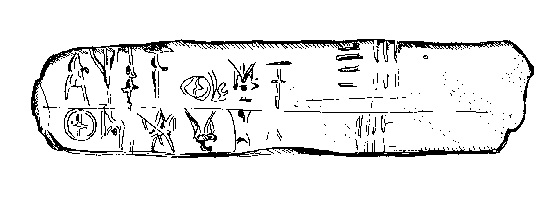
Eine auf Kreta entdeckte Tafel mit Linear B-Schrift und dem Symbol des Trelleborg-Quadranten (unten links)
In antiquity the term “holy” was usually used in the sense of “charged with special energy”. The mighty energies the Gods dealt with were “holy”.
Not only did “objects” become translucent white from the water of Urd’s fountain. The area around Urd’s fountain, says Preben Hansson, “is still brighter than the rest of the surrounding meadow”.
What was the use of water that even was able to bleach the soil?
Hansson sees in it an insulating impregnating liquid. “It is extremely interesting that the liquid contained quartz and mica (in the clay)” – materials that are to a large extent insensitive to temperature fluctuations. And: “No acid attacks them, and the material is the absolute best electrical insulator.”
Evidence for Hansson, “that these fantastic edifices in the Trelleborg complex were technical marvels”.
Hansson’s contention was further underlined by the exact cruciform structure that in the clearly discernible Trelleborg complex, near his home city of Slagelse, had a beam length of 140 metres. This gigantic cross, also clearly seen in the smaller Fyrkat complex, is astonishingly evocative of a modern interferometre.
The radio telescope Jodrell Banks in Great Britain, Hansson says, “could have been erected on the ground plan of one of the Trelleborg complexes”.
The symbol of that very structure – a cross surrounded by a circle – was found in Denmark in masses. Preben Hansson found two such stone scorings near Trelleborg. And Danish archaeologists also catalogued hundreds of such stone symbols in a total of 59 places, in Djursland, Northwest Seeland, Bornholm, Himmerland and Gotland.
The stone drawing of Bohuslän on Gotland shows the ring-like square motif together with a human form that with the help of circle and cross lifts into the air.
Parallels to the Technical Genius Nikola Tesla
Hansson felt more and more reminded of Nikola Tesla, a true techno magician of modern times. Tesla was more than one hundred years ahead of his time.
When in 1892 Edison electrified the town New York, Tesla in Buffalo Springs was already a giant step ahead: He managed to get 200 carbon filament lamps along a distance of forty kilometres to glow by using wireless energy transmittance.
In 1931 he drove for one week with his nephew in a luxury car, a Pierce Arrow, in the countryside along the Niagara Falls without having to visit a petrol station.
His car was powered by a electro motor that Westinghouse had constructed according to his designs. The engine itself received the energy from a converter connected ahead that collected the necessary energy via a finger-sized aerial. Today, the car and the converter are missing.
Tesla’s crowning achievement was the construction of his “Magnifying Transmitter” on Rhode Island near New York. “The core of he setup”, so it is written in a memorandum titled Nikola Tesla’s Legacy, “was a sixty metres high tower whose mushroom-shaped cap was constructed as a copper electrode with a diameter of thirty metres”.
This setup delivered such gigantic energies that Tesla in high-performance tests, going to full whack so to speak, was able to produce earthquakes and thunderstorms with lightning and thunder – exactly like Baal in Kanaan, Telipinu in Hatti and Zeus in Hellas.
His financier Pierpont Morgan – at the time one of the wealthiest industrialists of America – feared that Tesla’s plans to provision industries, buildings and vehicles “at no profit” could reduce the capital gains: “For heaven’s sake, then we will only sell a few boxes and antennas and can write off our profitable heavy technology.”
Morgan axed his funding and Tesla had to abandon his project on Rhode Island. He never again found a financier who would have enabled him to continue developing his Magnifying Transmitter and enlarge it to a large system – what probably would have spared us today a great many environmental problems.
But what of this Tesla transmitter? In his book My Inventions Tesla describes the function of his transmitter:
“It is a resonance transformer that, when it is exactly proportioned to the globe will be most effective in the production and wireless transmission of energy with high efficiency. Distances become irrelevant as there is no loss during transmission. The energy can be transmitted wirelessly as operating power to any vehicle on land, on water or in the air or be used to remotely control these vehicles.”
And: “Installed all around the globe it could supply a wide belt with energy and means of communication.”
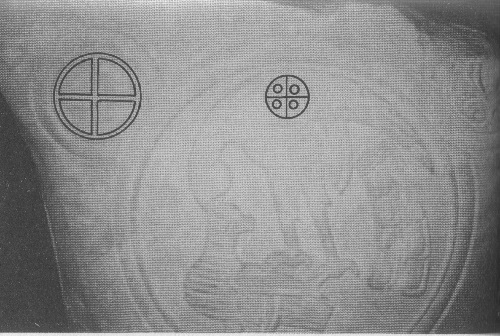
Im Museum von Dodona findet sich diese Darstellung des Trelleborg-Quadranten auf einem Vogel
Bifröst and the Ascension to the “Heavenly Abodes”
Here we return to Hyperborea, to Odin and the Æsir, the guardians of the “support beam of heaven”, in which we recognise the ash tree Yggdrasil.
They built a “bridge from earth to the heaven that is called Bifröst”. Bifröst is “tricolour, very strong and made with more sense and art than other handiwork”.
This “bridge” of the Æsir “burns in flames, and hot are the heaven’s waters”. Daily “the Æsir ride across Bifröst up to heaven”.
Hereby “ride” seems to be a paraphrase of “fly”, for a horse carries its rider neither through flames nor up to heaven.
And indeed, many Nordic sources talk of the “flying Æsir”. Here are some examples from the “Nordic God sagas”:
“Odin, Thor, Freyja, Frigg and Hermod rode and flew often together, and Freyja flew in her feather coat.”
“Loki loved to travel, especially to fly.”
“Surtr flew after them until they arrived over Asgard.”
“Nidhög hovered away over their heads.”
Before this background golden-bristled boar Gullinbursti of Freyr that the dwarfs Sindri and Brokk had “forged” seemed to be a fast and manoeuvrable aircraft, whose form probably intentionally was akin to a frenzied tusker.
A similar rhyme we can make on Odin’s eight-legged (eight-engined?) horse Sleipnir.
But when now Odin, Freyr, Baldr or Heimdall rose into the northern heaven to get to their “heavenly places”, the flight route had to be exactly defined.
For the gigantic magnetic fields surrounding the Earth only leave narrow lanes that could be negotiated without danger by the astronauts.
The experienced pilot Preben Hansson said to this:
“Astronauts … cannot leave the Earth at any old place, but only following a course that brings them to the largest possible distance from the magnetic force fields over the North Pole, but also to the largest possible distance to the magnetic force fields of the Van Allen belt …”
And he continues: “… And this direction is identical with the course of Trelleborg via Eskeholm, Fyrkat and Aggersborg and then out into space”!
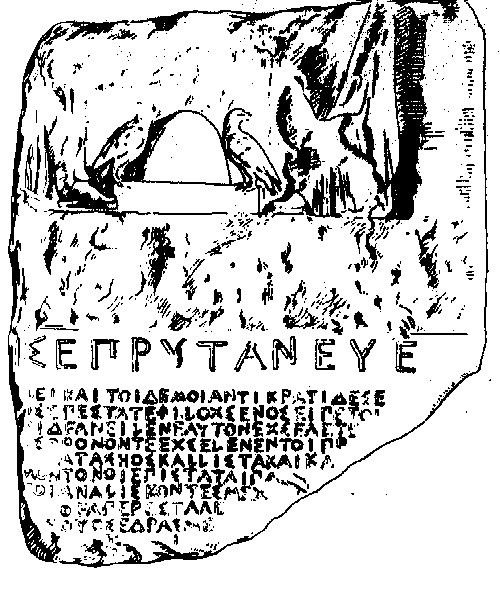
Der „sprechende Stein“ wurde fast durchgängig gemeinsam mit Vögeln, den Symbolen des Flugverkehrs, dargestellt
Before we further follow the course to the “Heavenly Abodes” we will check whether the fire bridge of the Æsir really would conform to the Tesla conditions to be installed “all around the globe” in order to supply “a wide belt with energy and means of communication”.
The Oracle Sites Once Were Technical Relay Stations
This exactly puts the rule to the test. If we expand the course found by Hansson to form a great circle (geodetic line) around the Earth, it will touch in the area of land surfaces and islands in a south-easterly direction the following antique cult places:
• the Oracle of Dodona in Ipiros near Ioannina
• the Oracle of Delphi at Mount Parnassos
• the Oracle of Knossos on Crete
• the Oracle of Siwa in North Africa
• the Oracle of Thebes in Egypt
• the Oracle of Napata in Ethiopia
We now take off and follow the great circle in a south-eastern direction!
First we fly over the Baltic and reach the Mecklenburg coast. In this area were once the legendary city of Vineta, now sunk into the sea, an ancient centre of the light religion. The course further leads, skirting Berlin to the East, across the areas of tree oracles and the ancient light religion in Bohemia.
Finally we arrive at the oracle of Dodona in the area of Ipiros, twenty-two kilometres from the town of Ioannina. Dodona is thought to be the oldest oracle of the Greek world. Herodotus tells in his “Histories” a symbolic tale about the formation of the oracle that points to an Egyptian origin of all the European oracles.
Once, in Thebes in Egypt – since the First Intermediate Period around 2100 BC, the seat of the great Amen-Re – two black doves soared up. One of the doves alighted in the oasis of Siwa in Libya, the other flew across the Mediterranean and landed in mountainous Ipiros.
In the beginning in Dodona the Great Mother Gaia sat under a holy oak (!). This was about 5’000 years back. Later, in the 13th century BC, the oracle was dedicated to Zeus.
The tree cult, says Philipp Vandenberg in his book Buch Das Geheimnis der Orakel (The Secret of the Oracles), also played an “considerable role” in the Minoan culture on Crete, and he mentioned the connection between the Dodonan oak cult and the cultic practices in Northern Europe, “where the Indo-European God of the Heavens in many places was worshipped in a holy oak tree”.
Preben Hansson visited Dodona and found there, in the centre of the cult site, the same “circular place” so typical for the Trelleborg complexes. Even the “curved escarpments” of the former circular rampart “still show as traces in the terrain”. A watercourse once flowed here that served as cooling water for the “fiery bridge”. Hansson even found the remains of a brick-built retaining basin.
And in the museum of Ioannina, in which the excavated artefacts of Dodona are exhibited, Hansson discovered a relief motif that shows the Trelleborg quadrant on the back of an eagle.
Our next station is the oracle of Delphi. According to Philipp Vandenberg there had been in the furthest antiquity a “mythical cult site” that had been under the authority of Phoibos Apollon.
Apollo is according to Ranke-Graves deduced of Abol = apple and points to the Apples of the Hesperides and to the Apples of Idun in Hyperborea. The addend “Phoibos” means “the Radiant”. In this way it follows that Phoibos Apollo encounters as “Radiant Apple God”, who sustained the closest relations to the “guardians of the support beam of Heaven”, the Æsir. Apollo was a son of Leto and Zeus-Baldr.
The Greek historian Petros Themelis (“The Delphi Museum”) mentions that Apollo “knew all about the Cosmos”, and that he knew “how to free oneself from the grip of matter”.
Apollo “travelled every year, from November to February … to the Hyperboreans where there were no illnesses and where people remained young forever”. In this winter break of Apollo the oracle was out of operation.
The first great temple with a golden statue of Apollo was – according to Vandenberg – built only in the 7th century BC – about 550 years after the Great Catastrophe that had ravaged Europe, Asia Minor and the whole Mediterranean area and brought Hellas a “dark age” lasting several hundreds of years.
The original materially-technically functioning Apollo oracle was continued after the 7th century BC by a female medium – the Pythia, who on the seventh day of each month in a fulminant state of intoxication stammered ambiguous oracles. The traditional winter break was maintained.
Delphi, on the southern slope of Parnassos, had from ancient times access to the crystal-clear water of the Catalian source, and Preben Hansson discovered at the edge of the amphitheatre erected later the original Trelleborg rampart.
In the centre of the oracle academic excavators found the very Omphalos, that for many oracles in the Mediterranean area and in the Near East had an equally great importance as the Cherubim on the Ark of the Covenant of Messe (“son”), who by the Hebrew translators of his writings was corrupted to “Mose” (pulled from the water”).
Omphalos (lat.: umbilicus) means “navel”. This Indo-European term is closely related to the Sanskrit word “nabh”. Nabh means “to radiate strongly” and is in turn related to the Hebrew “naboh” (“predict”) and “nabih” (“prophet”).
The common roots unites all these terms in one of the oldest cultural languages of the Earth. The Sumerian term “naba” means: “radiant stone that explains”. This explains Zecharia Sitchin (The Twelfth Planet) who is able to read the old languages in the original.
An Omphalos looks like a halved egg and with the later medial oracle priestesses had a symbolic rather than a functional meaning. The stone Omphaloi found by archaeologists in Delphi, Siwa, Napata, Palmyra and in other places represent replicas of the original “talking stones” who in Sumerian literature, the very oldest, often are mentioned in connection with telephonic communication.
Such a “talking stone” was basically a technical crystal. Once we reach the oracle of Siwa we will learn more concerning this question.
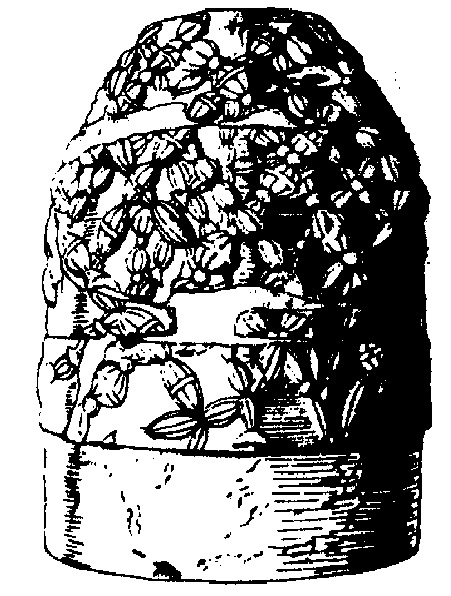
Die Trelleborg-Anlage von Delphi, im 7. Jahrhundert zum Orakel umgerüstet, barg den Omphalos, der in Sumer als „sprechender Stein“ bekannt war
If we follow the Great Circle further in a South-Eastern direction, it touches in the Mediterranean the oracle of Knossos near Iraklion where the Cretan cult of the tree oracle had its centre.
In the museum of Iraklion a clay tablet found in Knossos is exhibited that contains characters of the so-called Linear B type. On this tablet the Trelleborg quadrant motif is clearly discernible.
Beyond the Mediterranean in the midst of the Libyan desert and exactly on the Great Circle line in the oasis of Siwa a limestone plateau on which still are the ruins of the old oracle.
Diodorus noted 2’000 years ago: “In the centre of the oasis is the fortress fortified with three-fold walls.”
Here once one of the “black doves” landed of which Herodotus wrote, and here, too, one rendered homage to the cult of the oracle oak, as Ranke-Graves mentions.
The oasis Siwa (ancient Egyptian: Sekhetam) is fifty kilometres long and on average five kilometres wide. Still today more than two-hundred springs assure the exuberant florescence of the verdant desert island.
The medial oracle system began here more or less at the same time as in Greece. Vandenberg dated this beginning – of which we in the meantime learnt that it had been a new beginning for other reasons and with simpler means – to the time of the 25th Pharaonic dynasty (712–664 BC).
This time is considered as the period of the Ethiopian “foreign rule”. It certainly is no accident that King Taharka – who in his capital city Napata had revived the oracle system – in his time as Egyptian Pharao also reactivated the compound in Siwa.
In Siwa as well as in Napata the international guild of spade researchers found that mysterious Omphalos we had already encountered at Delphi.
Let us hear Quintus Curtius, the Roman historian, quoted by Sitchin: “The thing that there” – in Siwa – “was worshipped as a God does not have the form that effigies normally have. It looks rather than an umbilicus and is made of an emerald and joined small precious stones.”
And Sitchin adds: “Amen’s Shrine in Siwa contained … a forbidden area surrounded by thick walls of about sixty square metres. In the centre was a firm stone platform. The same complex including the raised platform we find at all the places” – in the Near East – “that are connected to the ‘whispering stones’. Do we … conclude from this that like the much larger Baalbek it had been a landing place and at the same time a communication centre?”
For at the monumental flying field at Baalbek in the Lebanon Baal-Zeus had communication by a “radiant stone that whispers”.
And Seti I. (1304–1290 BC) on a huge wall relief had depicted technical procedures that are connected with the – in his time long-destroyed – space-flight facility Duat in the Sinai.
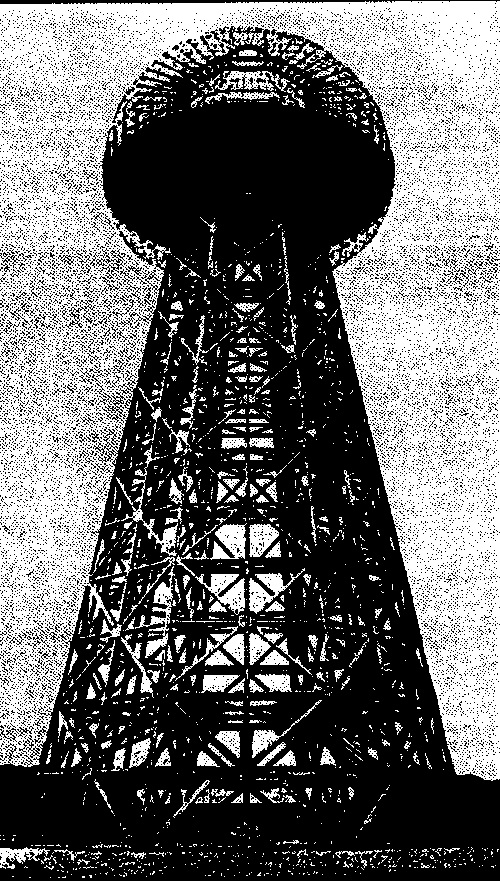
Der „Verstärker-Sender“ Nikola Teslas auf Long Island. Diese Technologie lag vermutlich auch der antiken Fluganlage zugrunde
The secret area of Seker was characterised by the typical symbol of Omphalos on which two birds sit. Through the Omphalos “every day words were spoken to Seker”.
A few centuries after Taharka, the oracle of Siwa reached everlasting fame. For Amen himself, the mighty Re acting in secrecy, gave the Macedonian King Alexander the arguably most important oracle of Greek history. Alexander as “bodily son” of Re was confirmed in his intention to subdue the whole Great Persian Empire.
And in the saddle of his Norwegian horse Bukephalos the “divine Iskander” overran the mellowed satrapies of the Persian Achemenides kings, overthrew the world dominance of Ahura Mazda and from Nile to the Indus planted the banner of Zeus Megistos – that “most great Zeus”, as whose son and executor Alexander acted.

Steindarstellung des Trelleborg-Quadranten
We now fly on the Great Cirle further to South-east – to the capital of Re, to Thebes, the splendor and monumentality still today takes the visitors’ breath away. How Weset – that was the name of the capital of Egypt itself – presented itself to the famous Egyptologist Jean Francois Champollion in the year 1828 is described by Erich Zehren in his book Scherben, Schriften und Geschichte (Shards, Writings and History).
On the Eastern banks of the Nile the traveller saw the immense temple of Luksor: “The white marble and the splendid halls of columns, the gigantic gates of the pylons, the immense, 14 metres high seated sculptures of Pharao Ramses II., the obelisk from rose granite …”
Amidst the mountains of detritus and ruins Champollion perceived “the incomprehensible wonder of a culture without match that more than three-thousand years ago had flourished here … As Champollion strode through the gigantic, almost 44 metres high and 113 metres wide temple gate of Karnak – whose mighty 15 metres strong stone blocks shielded the sanctuary – he entered the largest court of all great temples of Egypt”.
Beyond this monumental desert of rubble Champollion entered a pillared hall that transcended the imaginative power by several orders of magnitude:
“On an area of 5’000 square metres a veritable woods of large sandstone pillars rose up. Arranged in 16 rows 134 pillars stood before him, every single on of them deeply impressed him. In the centre twelve 21 metres high ‘papyrus columns’ stood, each with a circumference of more than ten metres. The rest of the 122 pillars are 13 metres high and have a circumference of almost nine metres”.
In a further immense hall Champollion saw “the largest obelisk of Egypt, of red granite … – a granite monolith of a height of almost thirty metres and of almost 350 tons (7000 quintals).”
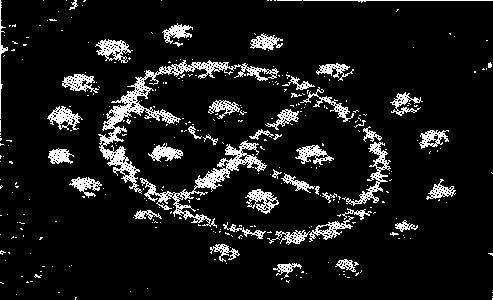
Darstellung des Trelleborg-Quadranten auf Stein
Later Champollion was to learn from the Harris papyrus that in holy Karnak once had stood the incredible number of 86’000 statues.
Champollion wrote to friends in France: “No people on Earth, none old and none modern, has understood the art of architecture to such an exalted and grandiose measure as the ancient Egyptians. They understood like 100 feet high people.”
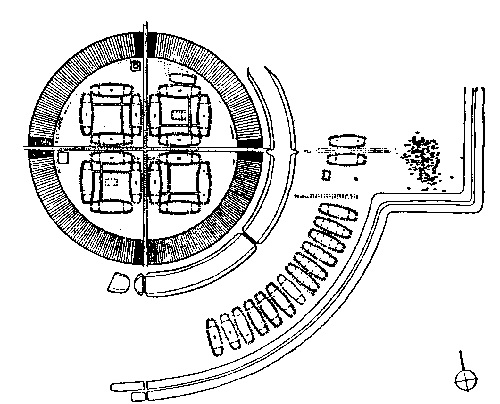
Grundriss der Anlage bei Slagelse auf Seeland (Dänemark)
The main oracle of Thebes, the centre of the former flying field, is completely destroyed – devastated by the Persian troops of Kambyses who, at the behest of the Ahura Mazda, almost 2’500 years ago most efficiently laid waste to the sanctuaries of Amen-Re. Here the archaeologists at least found the stone replica of an Omphalos.
The oracle of Napata, the Nubian-Egyptian pyramid town, was also dedicated to Amen-Re, and this oracle also contained an Omphalos in its centre, as we already had learned. The town lies at the fourth Nile cataract and thus possessed – as all other oracle site observed – copious amounts of cooling water for the erstwhile running of the “fiery bridge”.
This short overview shows that in antiquity technologies had been employed that even today had not been redeveloped. And more: Nikola Tesla’s legacy – of which the Bifröst flying line reminded Preben Hansson so vividly – was carefully hidden away in American strongrooms. Tesla’s technique for wireless transmission of energy is more than a hundred years old. It is not the technological advanced state in antiquity alone that is carefully withheld in schools and universities. The technological legacy of Nikola Tesla has also been dwindled away to the naming of the magnetic field strength.
We now have got to know about the ancient Great Circle flying line in Europe and Africa. In a further treatise we will look at the flying technology of the Anunnaki that was also accessible to the descendents of Noah. This article is titled: “Vimanas and Sabhas”.
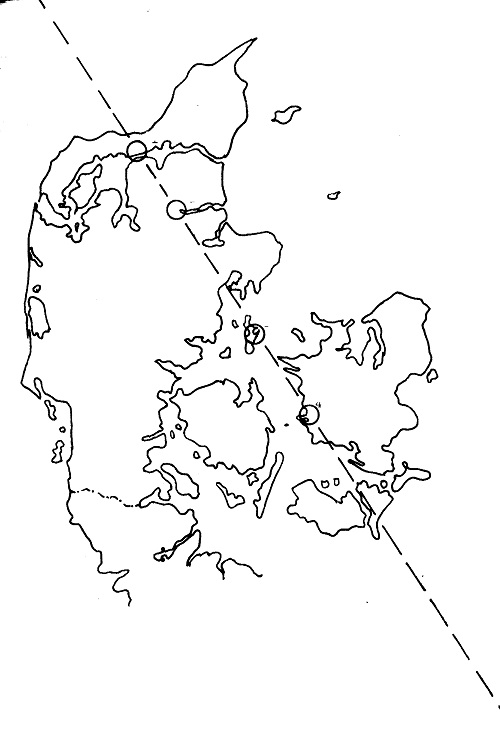
Die Asenbrücke: Kartographische Darstellung der Fluglinie auf dänischem Gebiet. Aus: Preben Hansson, Und sie waren doch da
This post is also available in: German
